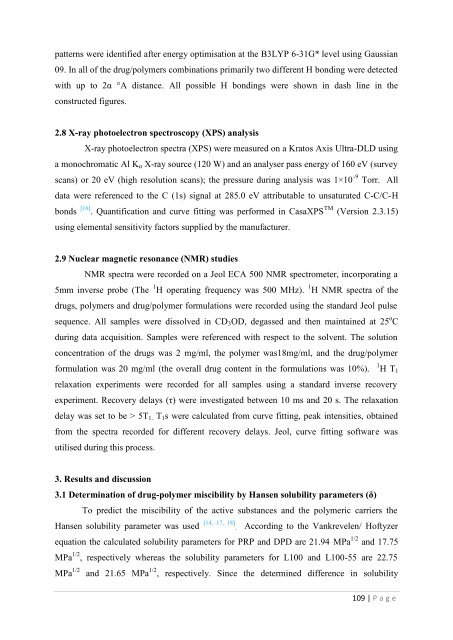Development of hot-melt extrusion as a novel technique for the ...
Development of hot-melt extrusion as a novel technique for the ...
Development of hot-melt extrusion as a novel technique for the ...
You also want an ePaper? Increase the reach of your titles
YUMPU automatically turns print PDFs into web optimized ePapers that Google loves.
patterns were identified after energy optimisation at <strong>the</strong> B3LYP 6-31G* level using Gaussian09. In all <strong>of</strong> <strong>the</strong> drug/polymers combinations primarily two different H bonding were detectedwith up to 2 °A distance. All possible H bondings were shown in d<strong>as</strong>h line in <strong>the</strong>constructed figures.2.8 X-ray p<strong>hot</strong>oelectron spectroscopy (XPS) analysisX-ray p<strong>hot</strong>oelectron spectra (XPS) were me<strong>as</strong>ured on a Kratos Axis Ultra-DLD usinga monochromatic Al K X-ray source (120 W) and an analyser p<strong>as</strong>s energy <strong>of</strong> 160 eV (surveyscans) or 20 eV (high resolution scans); <strong>the</strong> pressure during analysis w<strong>as</strong> 1×10 -9 Torr. Alldata were referenced to <strong>the</strong> C (1s) signal at 285.0 eV attributable to unsaturated C-C/C-Hbonds [16] . Quantification and curve fitting w<strong>as</strong> per<strong>for</strong>med in C<strong>as</strong>aXPS TM (Version 2.3.15)using elemental sensitivity factors supplied by <strong>the</strong> manufacturer.2.9 Nuclear magnetic resonance (NMR) studiesNMR spectra were recorded on a Jeol ECA 500 NMR spectrometer, incorporating a5mm inverse probe (The 1 H operating frequency w<strong>as</strong> 500 MHz). 1 H NMR spectra <strong>of</strong> <strong>the</strong>drugs, polymers and drug/polymer <strong>for</strong>mulations were recorded using <strong>the</strong> standard Jeol pulsesequence. All samples were dissolved in CD 3 OD, deg<strong>as</strong>sed and <strong>the</strong>n maintained at 25 o Cduring data acquisition. Samples were referenced with respect to <strong>the</strong> solvent. The solutionconcentration <strong>of</strong> <strong>the</strong> drugs w<strong>as</strong> 2 mg/ml, <strong>the</strong> polymer w<strong>as</strong>18mg/ml, and <strong>the</strong> drug/polymer<strong>for</strong>mulation w<strong>as</strong> 20 mg/ml (<strong>the</strong> overall drug content in <strong>the</strong> <strong>for</strong>mulations w<strong>as</strong> 10%).1 H T 1relaxation experiments were recorded <strong>for</strong> all samples using a standard inverse recoveryexperiment. Recovery delays () were investigated between 10 ms and 20 s. The relaxationdelay w<strong>as</strong> set to be > 5T 1. T 1 s were calculated from curve fitting, peak intensities, obtainedfrom <strong>the</strong> spectra recorded <strong>for</strong> different recovery delays. Jeol, curve fitting s<strong>of</strong>tware w<strong>as</strong>utilised during this process.3. Results and discussion3.1 Determination <strong>of</strong> drug-polymer miscibility by Hansen solubility parameters ()To predict <strong>the</strong> miscibility <strong>of</strong> <strong>the</strong> active substances and <strong>the</strong> polymeric carriers <strong>the</strong>Hansen solubility parameter w<strong>as</strong> used [14, 17, 18] . According to <strong>the</strong> Vankrevelen/ H<strong>of</strong>tyzerequation <strong>the</strong> calculated solubility parameters <strong>for</strong> PRP and DPD are 21.94 MPa 1/2 and 17.75MPa 1/2 , respectively where<strong>as</strong> <strong>the</strong> solubility parameters <strong>for</strong> L100 and L100-55 are 22.75MPa 1/2and 21.65 MPa 1/2 , respectively. Since <strong>the</strong> determined difference in solubility109 | P a g e
















